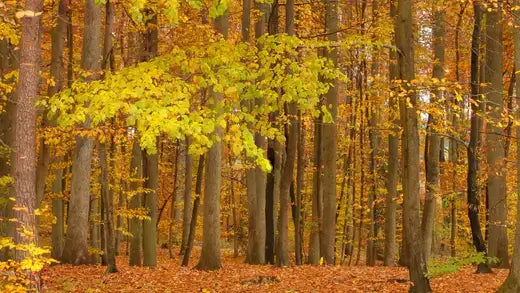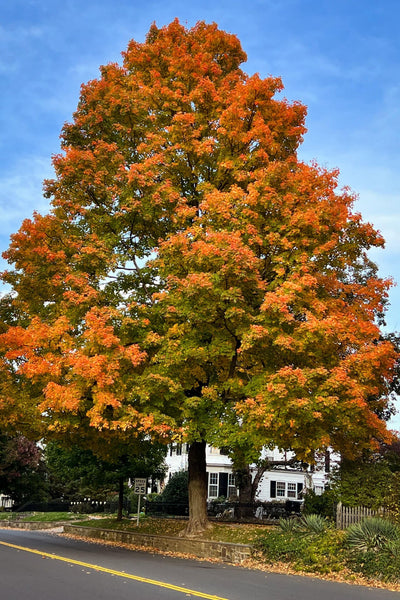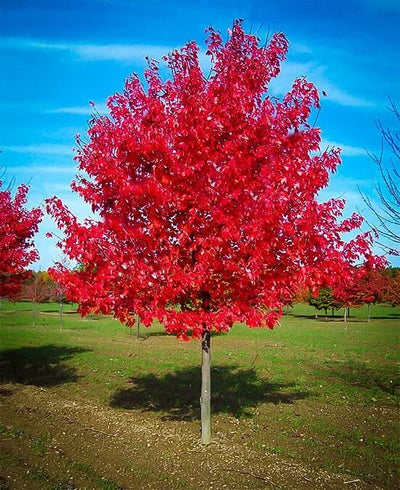The Pin Oak tree (Quercus palustris) is a classic example of a native tree known for its distinctive leaves and adaptability to various environments. This article will delve into ten native trees with characteristics and benefits similar to the Pin Oak.
1. Red Maple (Acer rubrum): The Red Maple is a versatile and fast-growing native tree across North America. Like the Pin Oak, its leaves turn vibrant shades of red in the fall. It is well-suited to wet and moist soils, making it an excellent choice for areas with varying water levels.
2. Northern Red Oak (Quercus rubra): As its name suggests, the Northern Red Oak is a member of the oak family. Its leaves resemble the Pin Oak, with deep lobes and pointed tips.
Sweet Gum Is An Amazing Native Tree
3. Sweetgum (Liquidambar styraciflua): The is valued for its star-shaped leaves that combine brilliant colors in the fall. Like the Pin Oak, it adapts well to different soil types and can thrive in wet areas. Its unique spiky fruit balls add visual interest to the tree.
4. American Sycamore (Platanus occidentalis): With its distinctive mottled bark and large, hand-shaped leaves, the American Sycamore resembles the Pin Oak in terms of its aesthetic appeal. It is often found near water bodies and is known for its rapid growth rate.
5. Shagbark Hickory (Carya ovata): The Shagbark Hickory stands out due to its shaggy bark that peels away in strips. Its foliage, though different in appearance from the Pin Oak, offers similar shade and contributes to its native ecosystem. This tree also produces edible hickory nuts.
6. Swamp White Oak (Quercus bicolor): As the name suggests, the Swamp White Oak is at home in wetter environments. Its leaves share some similarities with the Pin Oak, and it is appreciated for its adaptability to both damp and well-drained soils.
7. American Hornbeam (Carpinus caroliniana): Also known as Musclewood, the American Hornbeam is a small tree with distinctive bark that resembles flexed muscles. Its serrated leaves provide a unique texture like the Pin Oak's. It thrives in shaded woodland areas.
8. Bald Cypress (Taxodium distichum): The Bald Cypress is notable for its distinctive appearance – it is a deciduous conifer with feathery foliage that turns rust-colored in the fall before dropping. It is often found in wetland areas and can tolerate standing water, similar to Pin Oak's adaptability to wet conditions.
9. White Ash (Fraxinus americana): The White Ash is another native tree with compound leaves that resemble those of the Pin Oak. It is known for its tall and straight growth, making it valuable for lumber. Unfortunately, it has been impacted by the invasive emerald ash borer in recent years.
10. Black Gum (Nyssa sylvatica): Tupelo is appreciated for its glossy green leaves that turn vibrant shades of red in the fall. It is often found in moist areas and is an important food source for various wildlife species. Native trees play a crucial role in our ecosystems, offering a myriad of unique and invaluable contributions that shape the environment, support biodiversity, and benefit wildlife and humans.
These Native Trees Make A Natural Landscape
Their uniqueness lies not only in their appearance but also in the services they provide to the planet. One of the most remarkable aspects of native trees is their adaptability to local conditions. This resilience makes them a cornerstone of ecosystem stability, helping to maintain the delicate balance of nature.
Biodiversity conservation is another standout feature of native trees. These trees provide habitat and sustenance for many native wildlife, including insects, birds, mammals, and fungi. Many of these species have intricate relationships with specific tree species – from using them as nesting sites to relying on their fruits as a food source.
Preserving native trees thus directly supports the survival of numerous species, contributing to the overall health of ecosystems. Moreover, native trees often offer unique cultural and historical significance. They have played a vital role in indigenous cultures worldwide for millennia, providing resources for food, medicine, shelter, and spiritual practices. These trees hold stories and knowledge passed down through generations, connecting people to their heritage and the land they inhabit. The benefits of native trees extend beyond ecology and culture.
They contribute to the improvement of air and water quality. In urban areas, native trees offer unique aesthetic and functional advantages. They provide shade, cooling the environment and reducing energy costs. Their presence in parks, streets, and green spaces enhances the overall well-being of city residents, providing spaces for relaxation and recreation.
Native Trees Often Face Threats
Native trees are not just ordinary components of our surroundings – they are an essential and unique part of the natural world. Their role in supporting biodiversity, cultural significance, and environmental benefits combine to make them invaluable. As stewards of the Earth, it's our responsibility to recognize and protect these remarkable trees, ensuring that their unique offerings continue to enrich our planet for generations to come.
Conclusion: Native trees play a crucial role in maintaining the health of our ecosystems. Trees like the Pin Oak have unique characteristics that contribute to their ecosystems, and exploring other native trees with similar attributes can help diversify our landscapes and enhance the benefits these trees provide.
Whether it's the vibrant fall foliage, adaptability to different soil conditions, or the habitat they provide for wildlife, each of these ten native trees has something unique to offer, just like the beloved Pin Oak. By incorporating a variety of native trees into our surroundings, we can ensure a thriving and resilient natural environment for generations to come.
The Benefits of Planting Native Trees
Local communities can significantly improve their environments through the act of planting trees. Native species selection delivers exclusive benefits that extend past typical tree planting advantages. Native trees represent plant species that, through millennia of evolution, have become well-suited to survive and flourish in their natural regional habitat alongside Indigenous wildlife and prevailing climate conditions. Choosing these native tree species helps establish healthy ecosystems and supports local wildlife while minimizing maintenance work and ensuring landscape resilience throughout time as you contribute to planetary protection.
Native trees exhibit natural adaptability, one of their primary benefits when planted in their local environment. These species evolved to match local climates and soil conditions, so they usually need less water, fewer fertilizers, and fewer chemicals. These trees face less stress from temperature fluctuations and seasonal precipitation changes because of their adaptation to local pests, reducing the need for additional care. Native trees reduce maintenance expenses over time while helping to preserve essential resources such as water. By staying healthier, native trees require less chemical treatment, which helps maintain environmental health.
Native trees provide unique benefits to wildlife, which non-native trees rarely offer. These trees serve as critical food sources and habitats for creatures that depend on their flowering, fruiting, and leaf cycles. Specific tree species provide nectar and pollen, which many native pollinators have evolved alongside through coevolutionary processes. When you plant regionally native trees, you maintain the ancient ecological balance between plant life and wildlife, which has developed over thousands of years. Your backyard becomes a lively and balanced habitat where local plants and animals live together without disruption.
Planting native tree species increases biodiversity in the area. Local plants fail to regenerate when one non-native species takes over an area by crowding them out. Non-native species create conditions that increase the risk of new pests and diseases emerging. Selecting native trees helps to protect the unique assortment of plants and animals that characterize each region. A balanced ecosystem containing various species provides essential services for human survival through wildlife protection, air quality, and water purity maintenance while stabilizing soils.
Native trees serve as important links to a region's cultural heritage by fostering a sense of place. They play a significant role in regional history and cultural traditions, helping modern inhabitants connect to their ancestral heritage. Caring for local tree species promotes community involvement because neighbors unite for landscape restoration projects and conservation activities. The joint effort enhances community connections while increasing people's enjoyment of their surrounding natural environment.
Native tree planting stands as a crucial component in combating climate change. All trees absorb carbon dioxide, yet healthy native trees maintain their strength throughout their lives by absorbing carbon effectively. Adapting to local conditions enables these trees to resist climate changes, pests, and diseases that could harm or destroy less adaptable tree species. When you choose native plant species, you commit to building a solid and enduring local ecosystem that yields advantages for the entire community.


